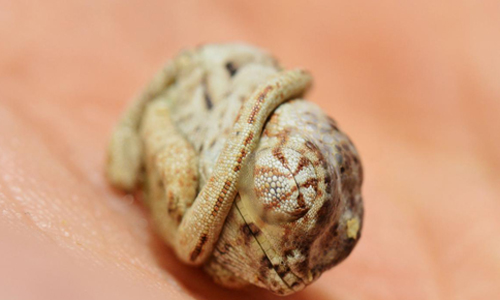Confusing reality in the experiment of breaking gecko eggs
Although the eggshell was broken, the gecko was still curled up like a hatched posture, making it impossible for scientists and breeders to understand why.
Mysterious experiment in breaking egg gecko
National Geographic reported on June 19 that Nick Henn, owner of a reptile store in Pennsylvania, USA used a pliers to cut gecko eggs and photographed a newborn leopard gecko . He thought that he would wake up and straighten himself, but the gecko still curled up as if he thought it was still in the egg.

The newborn leopard chameleon still curls up even though it has hatched.(Photos: NG)
Nick Henn likes to breed and breed geckos, especially Madagascar-based leopard chameleon. Eggshell and skin of chameleon color are similar. After 7-8 months in the egg, the young gecko will use the teeth on the inner lining.
That process "is like a swimmer removing a wet suit ," Robin Andrews, a biologist, described.
They then break the eggshell near the head to make it easier to move. This process may take up to a day. Leopard chameleon must manage itself, if it is impossible to break this shell, they will die.
Henn's leopard chameleon is only half successful in breaking the eggshell itself. Thankfully Henn intervened in time. However, there is no clear explanation why it is still in a curled up sleep position.
One explanation is that light is not strong enough. In Henn's experience, geckos are kept in eggshells for a long time and when exposed to light, "they wake up and know it's an exciting start."
Chameleon loves sunbathing and light sensitivity. They depend on the sun to warm the body as well as to set the biological clock. Reptiles often perceive light through a head component.
"It's like a separate window, helping geckos feel the time and light cycles of the day," said Brett Baldwin, San Diego zoo director.
In general, chameleon hatching in captivity is " difficult and complicated, " Baldwin added. The growing "babies" are sensitive to any slight change in temperature and humidity. In nature, chameleon blooms in dark underground caverns.
The lack of light may even hinder them from breaking their own shells, Andrew explained. It is also a reality of nature, many organisms lay a series of eggs to maintain the breed because only a small percentage of individuals can exist. Small chameleon is always a good prey for carnivores. As for this leopard leopard, he is living well after the first challenges in his life.
- Video: Funny experiment with eggs
- Discover new species of gecko
- Unknown things about the world of geckos are amazing
- Discover new species of gecko in Vietnam
- The discovery of gecko fossils lies in amber dating from nearly 100 million years
- The golden snake tree plays a gecko in the secret
- Simple experiment to turn eggs into transparent balls, bouncing like table tennis
- Marvel at the form of
- Video: Specialized desert gecko
- Should eggs be eaten every day?
- Video: Beating eggs under the sea
- 7 ways to eat nutritious eggs without getting bored
 Animal 'suffering' after hibernation
Animal 'suffering' after hibernation Why do goats climb well?
Why do goats climb well? Scientists were surprised to see chimpanzees eating turtles
Scientists were surprised to see chimpanzees eating turtles Giant catfish died deadly due to drought in Thailand
Giant catfish died deadly due to drought in Thailand